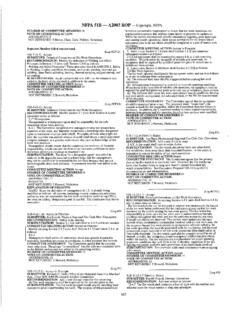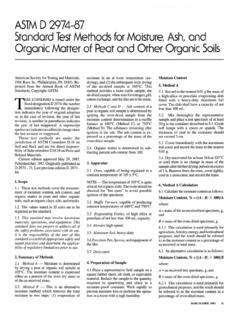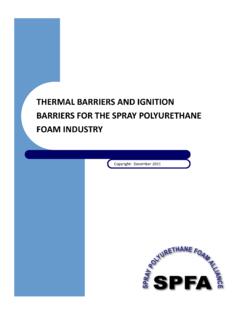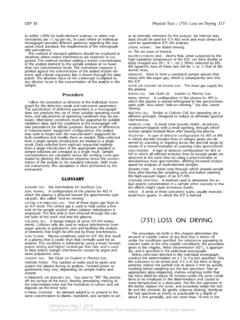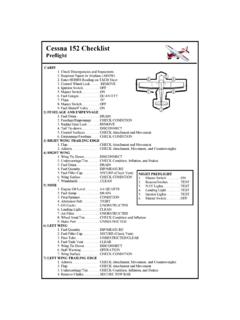Transcription of North American Standard Level I Inspection Procedure
1 Commercial Vehicle Safety Alliance 6303 Ivy Lane, Suite 310, Greenbelt, MD 20770 Phone: 301-830-6143 Commercial Motor Vehicle Safety and Security 2015 Commercial Vehicle Safety Alliance All rights American Standard Level IInspection ProcedureFor Levels II, III, IV, and V, omit steps that do not more detailed information, see the written procedures contained in the CVSA Operations 13141nnSTEP 1 Choose the Inspection Site Select a safe location, paved, Level , away fromtraffic, visible to traffic, and able to support theweight of the vehicle. Avoid hills, curves, soft shoulders and con-struction sites. You must be visible to oncoming 2 Approach the Vehicle Observe the driver. Adhere to officer/inspector safety policies. Be alert for leaks, unsecured 3 Greet and Prepare Driver Identify yourself.
2 Ensure that the driver is capable of communicat-ing sufficiently to understand and respond toofficial inquiries and directions. Place chock blocks on the driver s side. Explain this Inspection Procedure . Ensure engine is off. Check seat belt usage and condition. Observe the driver s overall condition for ill-ness, fatigue or other signs of impairment. Check for illegal presence of alcohol, drugs,weapons or other 4 Interview Driver Ask for the following from the driver: startinglocation, final destination, load description,time traveled, most recent stop, fueling loca-tion(s). Talk to the driver about the 5 Collect the Driver s Documents Medical Examiner s Certificate (if applicable). Skill Performance Evaluation (SPE)Certificate (if applicable). Driver s license, CDL, record of duty status.
3 Shipping papers. Periodic Inspection certificates, CVIP. Supporting documents: bills of lading, receipts,other documents used to verify record of 6 Check for the Presence ofHazardous Materials/TransportationofDangerous Goods Check shipping papers, placards, any leaks orspills, unsecured cargo, markings and 7 Identify the Carrier Identify carrier using the following:vehicle identification, vehicle registration,insurance, operating authority, driver 8 Examine Driver s License Expiration date Class Endorsements Restrictions StatusnnSTEP 9 Check Medical Examiner sCertificate and Skill PerformanceEvaluation (SPE) Certificate (If Applicable) Check certificate date (may be valid for up to24 months). Check corrective lens requirement. Check hearing aid requirement. Check physical :In Canada and Mexico proper class indicates adequate 10 Check Record of Duty Status Hours of Service verification.
4 If driver claims to be exempt, check that drivermeets all criteria for said exemption(s). Check accuracy of 11 Review Driver s Daily VehicleInspection Report (If Applicable) Review the required vehicle Inspection report toverify that listed safety defects have been certi-fied as corrected. Check for driver signature on previous inspec-tion 12 Review Periodic InspectionReport(s) Ensure vehicle has passed the required inspec-tion and has the required documents and 13 Prepare Driver for VehicleInspection Explain the vehicle Inspection Procedure . Advise the driver in the use of hand signals. Check chock blocks. Prepare the vehicle, vehicle transmission inneutral. Engine off, key must be in the on position, and release all brakes. Instruct driver to remain at the 14 Inspect Front of Tractor Check headlamps, turn signals (do not usefour way flashers to check turn signals) and allother required lamps for improper color, opera-tion, mounting, and visibility.
5 Check windshield wipers for improper opera-tion (two wipers are required unless one canclean the driver s field of vision). Rev. January 2015nnSTEP 15 Inspect Left Front Side ofTractor Check front wheel, rim, hub, and 16 Inspect Left Saddle Tank Area Check fuel tank area. Check exhaust 17 Inspect Trailer Front Check air and electrical lines. Check 18 Check Left Rear Tractor Area Check wheels, rims, hubs, and tires. Check lower fifth wheel. Check upper fifth wheel. Check sliding fifth wheel. Check all required :Never place yourself in between tires oftandem 19 Inspect Left Side of Trailer Check frame and body. Check condition of hoses. Check van and open-top trailer bodies. Check cargo 20 Inspect Left Rear TrailerWheels Check wheels, rims, hubs, and tires.
6 Check sliding 21 Inspect Rear of Trailer Check tail, stop, turn signals, all other requiredlights and lamps/flags on projecting loads. Check external ABS malfunction lamp. Check cargo 22 Inspect Double, Triple andFull Trailers Check safety devices on full trailers/converterdollies. Check the safety devices (chains/wire rope) forsufficient number, missing components,improper repairs, and devices that are inca-pable of secure attachments. Inspect pintlehook, eye and drawbar for cracks, excessivemovement, and improper 23 Inspect Right Rear TrailerWheels Check as in step 24 Inspect Right Side of Trailer Check as in step 25 Inspect Right Rear TractorArea Check as in step 26 Inspect Right Saddle TankArea Check as in step 27 Inspect Right Front Side ofTractor Check as in step 28 Inspect Steering Axle(s) Check steering system (both sides).
7 Check front suspension (both sides). Check front axle. Check frame and frame assembly. Check front brake components (both sides). If applicable, mark pushrods (both sides).Note:Inform the driver that you are going underthe vehicle. Enter the under carriage in view ofthe driver. (At front of power unit, rear of powerunit, and in front of trailer axle(s).nnSTEP 29 Inspect Axles 2 and/or 3 Check driveline/driveshaft. Check suspension (both sides). Check frame and frame assembly. Check brake components (both sides). If applicable, mark pushrods (both sides). Exit under carriage in view of 30 Inspect Axles 4 and/or 5 Same as step 31 Check Brake Adjustment Ensure air pressure is 90 100 psi. Have driver fully apply brakes and hold. Measure and record all pushrod travel.)
8 Identify size and type of brake chambers. Ensure brake lining to drum contact. Listen for air 32 Inspect Tractor ProtectionSystem (This Procedure tests both thetractor protection system and the emer-gency brakes.) Have driver release brakes and disconnect bothbrake lines. Full brake application. Listen for air 33 Inspect Required BrakeSystem Warning Devices Observe the dash panel area when the key isturned on for the function test of the ABSmalfunction lamp(s) (if applicable). Observe dash gauges while ignition is on andthe driver is pumping the foot valve to approx-imately 55 psi for the function test of a low airpressure warning 34 Test Air loss Rate Apply brakes while the engine is idling, thegovernor has cut in, and pressure is 80-90 35 Check Steering Wheel Lash Measure steering wheel lash while wheels arestraight and the engine is 36 Check Fifth Wheel Movement Prepare the driver and vehicle.
9 Check for excessive :If conducted improperly, this method ofchecking for fifth-wheel movement can result inserious damage to the vehicle. Use caution andinstruct the driver 37 Complete the Inspection Complete documentation. Conclude with driver. Follow correct and current OOS procedures (ifapplicable). Issue CVSA decal(s) (if applicable).1931, 33, 34,35 & 3721 2823 201824252627321722 (if applicable) 30 & 31 (under carriage) 29 & 31 (under carriage) 28161536 ABS Inspection Field ReferenceAir Brake Equipped VehiclesTrailer-mounted ABS malfunction lamp must cycle on then off when power is applied.
10 Have the driver apply service brake and hold. If the trailer lightdoesn't cycle, disconnect and reconnect electrical power to trailer (thisensures ABS circuit is interrupted for trailers receiving full-time power). ABS malfunction lamp on trailer must cycle when power is ABS malfunction lamp must cycle on then off when power isapplied. If the trailer ABS malfunction lampdoesn't cycle with the key on, disconnect andreconnect electrical power to trailer (this ensuresABS circuit is interrupted for trailers receivingfull-time power). ABS malfunction lamp on trailermust cycle when power is dash-mounted trailer ABS malfunction lamp and trailer-mounted ABS malfunction lamp must both cycle (on then off) for proper system lamps must cycle when the ignition key is turned on or when power is restored through the pigtail connection. Normal operation of the lamps isthrough the ignition key, but trailers receiving full-time power will require the disconnecting and reconnecting of the electrical power to the trailer (thisensures the ABS circuit is interrupted).

